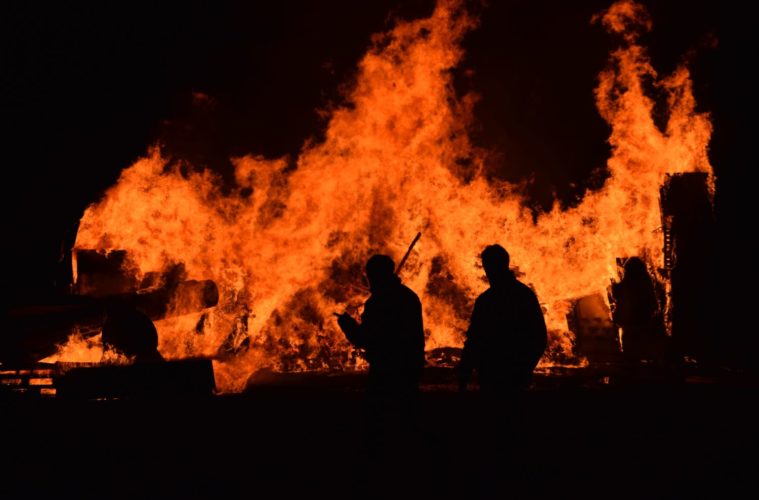The cannabis community is dealing with fire season as producers and dispensaries work to support their communities through yet another difficult year.
In this weirdly evil parallel tale, the legal cannabis industry in California has grown alongside ever-raging fire seasons that see records broken almost annually. As recent hurricane news cycles have spoken of hundred-year floods happening more often, the same can be said for the intensity of fire season in recent years.
So far, the sectors of the industry impacted the hardest are the cultivators and other businesses along the Sierra Nevada corridor and the northeastern section of the Emerald Triangle. All these regions also saw many hurdles for cultivators attempting to make the switch to the legal market in recent years. So the possibility of a lost crop could be a devastatingly compounding problem on top of still catching up on the expenses they incurred to get open not that long ago.
Last night, Cal Fire noted 15,500 personnel are currently battling 14 active large wildfires. Their efforts include 853 engines, 293 handcrews, 357 bulldozers, 404 watertenders, and 109 helicopters.
Approaching a million acres, the 922,129-acre Dixie Fire has had a major impact on the cultivators across the northern Sierra. Shasta and Butte are the two most cannabis-heavy counties of the five impacted, however, the whole region is filled with cultivators that serve both the regulated and traditional markets.
The largest fire to affect the Emerald Triangle this year has been the Monument Fire that’s burned 189,366 acres since the evening of July 30th and is currently 41% contained. It has burned exclusively in the heart of northern Trinity County while the McFarland Fire to the south has burnt across Shasta, Trinity and Tehama counties. The McFarland Fire is 122,653 acres and 93% contained. Smaller incidents have also happened in Humboldt. The Knob Fire has burned for a week there; it’s currently at 2,421 acres and 91% contained.
For those cultivators that wanted to live a bit closer to Lake Tahoe when setting up shop, the Caldor Fire has been devastating. 217,569 acres have burned southwest of Lake Tahoe over the last month.
Cody Bass serves on the South Lake Tahoe City Council and founded the region’s original dispensary: Tahoe Wellness Center. Bass emphasized how thankful a community that wasn’t sure it would return home is for the firefighters that made it happen.
Bass was under the impression that his dispensary was the first business to reopen in town after the evacuation order was lifted.
“We opened up like three days ago, we were actually the first,” Bass told L.A. Weekly, “We were open before the grocery store; we opened the morning they lifted it.”
He said the most noticeable aftermath so far, as life edges closer to normal, is the wider appreciation for the town and community itself.
“Big smiles and people are incredibly grateful that they’re able to return home, but of course you know like a lot of people I think left town thinking they may never come back. So there’s a lot of kind of grateful energy in people that are really just so thankful for the firefighters, and the effort to put out the fire or to divert the fire away from South Lake Tahoe.”
Bass said in his younger years he’d have never thought that the Tahoe region would be under threat of being fully destroyed.
“I mean, but the reality is when you look at Paradise or you look at Santa Rosa, or you look at what we’ve seen through the past two years, it is a possibility,” Bass said. He pointed to hopes of better forest management, but agreed climate change is certainly a factor in things intensifying,
The fires hitting the industry the hardest represent more than half of the 2 million acres that have burned in California this year. And while the numbers may already seem vast, the footprint of those fired on cannabis is far more widespread.
In terms of devastation, the acreage burned does not account for the smoke traveling through the hills and sticking to the resin on plants close to a full term as they finish up before the final harvest. The terps are ruined forever and the hills of California are dotted with stories of people who could not sell their crop in recent years due to smokey harvest.
Some of the material will be able to be remediated into extracts. But 99% of the time they’ll end up smelling like a weird chemical limeade thing. And this year more than ever there will be less need to process damaged material since so many people went harder on the first round of light deps.
But despite the challenges, farmers still prepare for the forthcoming harvest and are ready to put their foot on the gas in the weeks to come. As wider communities backboned by cannabis grown in them attempt to be prepared, they know lightning strikes or a change in the wind could dictate their economic situation for the next year.
Good luck to everyone up north in the weeks ahead before the first rains come and stay safe.
Advertising disclosure: We may receive compensation for some of the links in our stories. Thank you for supporting LA Weekly and our advertisers.

